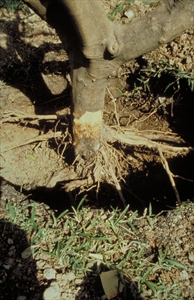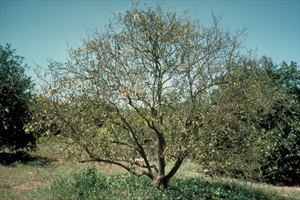Citrus root and collar rot, Phytophthora foot and root rot (Phytophthora nicotianae), and brown rot of citrus fruit (Phytophthora citrophthora).
Pacific Pests, Pathogens, Weeds & Pesticides - Online edition
Pacific Pests, Pathogens, Weeds & Pesticides
Citrus root & collar rot (264)
Two species are commonly found causing root and collar rots on citrus: Phytophthora nicotianae, and Phytophthora citrophthora.
Citrus root and collar rot (Phytophthora nicotianae) occurs on bele (see Fact Sheet no. 149), citrus, papaya (see Fact Sheet no. 152), passionfruit (see Fact Sheet no.154), pineapple, tobacco, tomato (see Fact Sheet no. 157) and many other hosts. Brown rot of citrus fruit (Phytophthora citrophthora) occurs most commonly on citrus.
Citrus root and collar rot diseases are common in wet areas (Photo 1). They cause a slow decline and death of citrus trees (Photo 2). The Phytophthora species involved are not fungi, although they have many fungal characteristics; they are water moulds or oomycetes, related to algae. They have motile spores and this sets them apart from fungi.
The two Phytophthora species cause similar diseases, and it is impossible to tell them apart on host symptoms. In general, Phytophthora citrophthora causes root and collar rots in cooler areas. There are also differences in appearance in culture, morphology and DNA tests.
The first sign of the diseases are spots on the trunk usually at the graft between the scion and rootstock or at soil level. The spots appear water-soaked, meaning they look wet, dark, usually sunken and greasy. The bark dies, dries and falls away, showing brown stained rots with cracks beneath. Often gum oozes from the wounds which can extend up to 50 cm above soil level and down to the roots. If the rot circles the trunk, the tree dies.
Root rots occur if soil moisture is high; in such situation the fibrous (fine) roots can be destroyed in a few days; the outer tissues become soft and are easily stripped leaving only the white inner more resistant part, called the 'stele'. If the soil stays wet for a more than a few days, the larger roots can also be affected.
As root and collar rots progress, leaves turn yellow, dry and fall, and branches die back. Initially, symptoms may be more obvious on one side of the tree, corresponding to the part of the root system with the most damage.
Fruit may also become infected by spores splashing from the soil, developing a firm, leathery, brown rot with a strong smell of fermentation. Fallen fruit also become infected. Stored fruit may show a white cottony growth of the water mould, especially if kept at high humidity.
Infection depends on: (i) the bark remaining in contact with wet soil at ground level; (ii) soil and air temperatures of 26-32°C; (iii) wounded bark; (iv) susceptibility of the variety.
Survival of the water moulds occurs as thick-walled resting spores called 'chlamydospores'. When conditions are right (temperatures of 32-36°C, and chemical stimulants from the roots), the chlamydospores germinate and produce spores called 'sporangia'. Yet another spore is produced inside the sporangia called 'zoospores' (see Fact Sheet no. 149), and these are capable of swimming short distances before germinating and infecting. Zoospores are attracted to roots by the chemicals that they produce.
Spread of citrus water moulds occurs when sporangia, zoospores, or chlamydospores, reach stems and trunks at soil level providing water is in contact with bark for at least 5 hours. They are also splashed in rain drops from the soil to the lower fruit. Spread over longer distances is by the movement of water on the surface or within soil; it also occurs in soil on machinery and footwear, and also by the movement of contaminated nursery plants. The disease is worse in wet, heavy soils that do not drain rapidly after rain, or are prone to floods.
Citrus root and collar rots are serious diseases, and occur in all citrus growing areas in the humid tropics. The impact of the diseases depends on the soil type, the rainfall, and frequency of flooding, and the rootstocks used.
Look for dieback symptoms, often on one side of the tree, and inspect the trunk at soil level. Look for bark that is dry and dying or dead, and cankers (often sunken open wounds) exuding gum. A culture of the oomycete is required for identification; this can be obtained from the margin of trunk lesions or from the lesions on fruits.
CULTURAL CONTROL
Cultural practices are important in the management of citrus root and collar rots.
Before planting:
- Avoid heavy, poorly drained soils, or dig drains or trenches to carry the water as quickly as possible away from the trees. Citrus requires good drainage!
- Bud high on root stocks (>30-45 cm) to avoid spores being splashed by rain onto susceptible parts of the stem or trunk.
- Ensure that nursery plants are free from Phytophthora species before field planting.
During growth:
- Keep weeds, including grass, away from the base of trees.
- Prune low hanging branches to at least 1 m above soil level.
- Frequently inspect trees, especially during the first 2 years after planting, and after flooding. Look for gum on the trunk. If infections are found, remove the affected bark and apply a fungal paste of, e.g., metalaxyl, phosphorus acid, or a copper fungicide.
- Remove soil (brought by ants) trapped behind tree guards on young trees, if these are being used.
- Avoid wounding the base of the trunks of the trees.
- Remove any trees with trunk infections that have led to their death.
RESISTANT VARIETIES
The choice of root stock varieties is very important in the management of citrus root and collar rot diseases. Which to use, however, depends on other diseases present, those caused by viruses and nematodes, especially. It also depends on the likelihood of the trees suffering from waterlogging, even if it only occurs occasionally.
Root stocks that have resistance to diseases include, trifoliate orange, sour orange, mandarin, and citrange hybrids. Swingle citrumelo, a hybrid between a grapefruit and a trifoliate orange is resistant to severe citrus tristeza, Phytophthora root rot, and has tolerance to waterlogging. Note that rough lemon and sweet orange are susceptible to Phytophthora root rots. It is important to ask local government experts for advice on the varieties to use.
In Fiji, the order of resistance to collar rot is trifoliate orange, sour orange, mandarin, sweet orange, grapefruit, bush lemon, lime, and Lisbon lemon.
CHEMICAL CONTROL
Apart from the use of fungicides to treat trunk cankers (see under Cultural Control above), their use is not recommended except in commercial production. Do the following:
- Apply foliar sprays of phosphorous acid, after times of flowering and the main leaf flushes. (Always refer to the product label for the correct method of application, timing, and also ways to avoid possible leaf burn.)
- Apply copper fungicides to protect lower fruit from spores in water splashed from the soil.
- Apply copper fungicides to the base of the trunk to prevent collar rots.
____________________
When using a pesticide, always wear protective clothing and follow the instructions on the product label, such as dosage, timing of application, and pre-harvest interval. Recommendations will vary with the crop and system of cultivation. Expert advice on the most appropriate pesticides to use should always be sought from local agricultural authorities.
AUTHOR Grahame Jackson
Information from Hardy S, et al. (2012) Impacts and management of flooding and waterlogging in citrus orchards. NSW Government Department of Primary Industries; and from CABI (2015) Phytophthora nicotianae (black shank) and Phytophthora citrophthora (brown rot of citrus fruit). Crop Protection Compendium. (https://www.cabi.org/cpc/datasheet/40983 and https://www.cabi.org/cpc/datasheet/40958). Photo 1 Kohler F, et al. (1997) Diseases of cultivated crops in Pacific Island countries. South Pacific Commission. Pirie Printers Pty Limited, Canberra, Australia. Photo 2 Diseases of fruit crops in Australia (2009). Editors, Tony Cooke, et al. CSIRO Publishing.
Produced with support from the Australian Centre for International Agricultural Research under project PC/2010/090: Strengthening integrated crop management research in the Pacific Islands in support of sustainable intensification of high-value crop production, implemented by the University of Queensland and the Secretariat of the Pacific Community.





